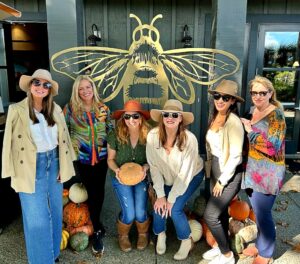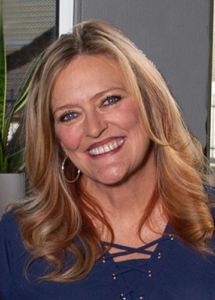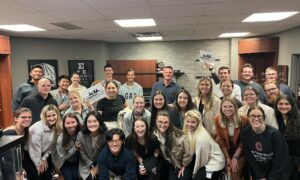
Dr. Sorrenson, second to left (as you are looking at photo) with her best friend, Bj (far right) at a celebration at Honig winery for Bj’s daughter, whose friends are also in the photo. Dr. Sorrenson says that independent optometric practices can learn from the success of many small, independent wineries.
What the success of another industry can teach optometry.
By Laurie Sorrenson, OD, FAAO
Nov. 15, 2023
A couple weekends ago, I was invited to go on a trip with my best friend, Bj Avery, to celebrate her daughter’s birthday with her friends. We embarked on a great winery tour, and while sipping excellent wines and soaking in gorgeous vineyard landscapes, I couldn’t help but draw parallels between our adventure and optometry (maybe because I am always thinking about my next column!).
It turns out that our enjoyable getaway was a microcosm of a broader trend – the consolidation of smaller, independent businesses by larger corporations and private equity firms.
Consolidation in the Winery Business
Our winery tour immersed us in an industry traditionally associated with charming, family-owned vineyards and personal attention. However, it has undergone significant changes as larger corporations and private equity firms have been acquiring smaller, independent wineries. We were told that many of the owners say they have sold out because their children went to school initially to learn business to run the winery, but then decided they did not want to do that and have left the winery business for other ventures. (Sound familiar?)
As we ventured from one winery to another, I reflected on how the changes in the wine industry mirrored trends in optometry. Independent optometry practices have faced increasing competition from large optical chains, vertical ownership of everything optometry and private equity firms that have bought some of the best optometric practices. Here’s how this shift in optometry has parallels with the wine industry:
- Technological Advancements: Small optometry practices, like boutique wineries, can face challenges in keeping up with the latest diagnostic, treatment and business technologies. Larger entities can more easily invest in equipment, training and more people to handle many of the business needs.
- Marketing and Branding: National companies with recognized brands and substantial marketing budgets can attract patients away from smaller, independent optometry practices that do not have the budget for this type of marketing. This is happening to the wineries too.
- Competitive Pricing: Economies of scale can enable larger companies to negotiate better deals with suppliers, leading to more competitive pricing for customers. Using resources like buying groups or collaborative partners like Vision Source and other groups can help a lot. Smaller wineries have the same issues negotiating pricing on their own.
Navigating the Changing Landscape
Our winery tour was a testament to how smaller, independent businesses can still thrive in an environment dominated by larger corporations and chains. We can take inspiration from their experience:
- Personalized Service: Boutique wineries and independent optometry practices can offer more personalized experiences that larger entities often struggle to replicate. Building strong patient relationships and providing exceptional service is a significant advantage. The key is to make this experience consistent, which isn’t always easy to do. Giving a “WOW” experience consistently is very difficult!
- Niche Markets: Smaller practices can carve out niche markets by specializing in unique offerings or services tailored to a specific clientele like a dry eye practice, vision therapy and neurovisual specialties. Most of these larger companies are not offering these types of services.
- Local Appeal: Studies show that patients say they prefer supporting local, independent businesses. Using the words “local” and “independent” in your internal and external marketing can help you maintain your patient base.
Our winery tour offered not just a delightful escape with friends, but a snapshot of broader business trends. The consolidation of smaller, independent businesses by larger corporations and private equity firms is reshaping both the winery and optometry industries.
Other Articles to Explore
As we celebrated the charm of boutique wineries, I realized that optometry can still thrive by capitalizing on our unique strengths, creating a consistent “WOW” patient experience, marketing that we are independent and locally owned, and just as importantly, remembering to embrace innovation and be bold.
 Laurie Sorrenson, OD, FAAO, is president of Lakeline Vision Source in Cedar Park, Texas, and the Professional Editor of Review of Optometric Business (ROB). To contact her: lsorrenson@gmail.com.
Laurie Sorrenson, OD, FAAO, is president of Lakeline Vision Source in Cedar Park, Texas, and the Professional Editor of Review of Optometric Business (ROB). To contact her: lsorrenson@gmail.com.



























